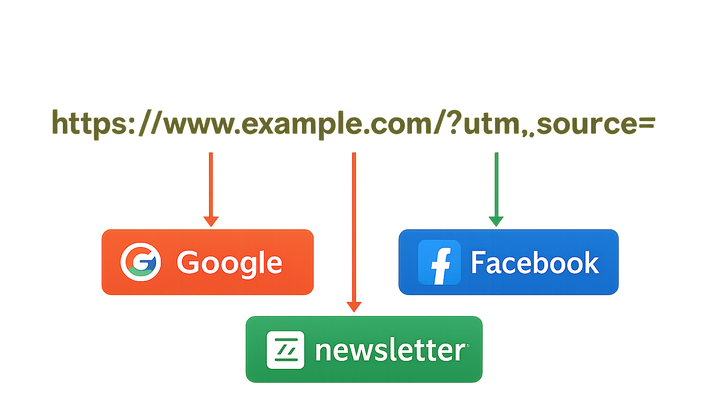Published on 2025-06-29T17:35:28Z
What is UTM Source? Examples of UTM Source in Campaign Tracking & Analytics
UTM Source is a key parameter in campaign tracking & analytics used to identify the origin of your website traffic. It’s appended to URLs to track which platform, channel, or specific referrer sent visitors to your site. By tagging links with utm_source, marketers can segment and analyze data in analytics tools to measure the performance of individual campaigns and traffic origins. UTM Source works alongside other UTM parameters (Medium, Campaign, Term, Content) to provide a detailed view of user acquisition channels. Whether you’re using simple analytics platforms like plainsignal or generative tools like UTMGuru, understanding and consistently applying UTM Source tags ensures accurate attribution and data-driven decision making.
Utm source
UTM Source tags identify the origin of traffic (e.g., Google, newsletter) for reliable campaign attribution.
Definition and Purpose
In campaign tracking & analytics, UTM Source is the parameter used to identify the origin of your website traffic. When appended to URLs, it denotes which platform or referrer sent the user (for example, google, newsletter, or partner_site). This information feeds into analytics tools, allowing marketers to segment data and attribute user activity to specific sources. By pinpointing traffic origins, teams can optimize budget allocation, content strategies, and campaign performance.
-
What is utm source?
UTM Source (utm_source) is a query parameter appended to URLs used to label the traffic origin. It can represent a search engine, social network, email newsletter, or any custom source.
-
Why utm source matters
UTM Source enables granular attribution by revealing where visitors come from, which informs decision-making on marketing investments and channel effectiveness.
How UTM Source Works
UTM Source operates within the URL structure, using key-value pairs to pass source information to analytics tools. It follows specific syntax rules and interacts with other UTM parameters to create a complete tracking data set. Proper construction and encoding ensure accurate data capture and reporting.
-
Url structure
A typical URL with UTM parameters looks like: example.com/?utm_source=google&utm_medium=cpc. The utm_source parameter directly follows the question mark or an ampersand.
- Parameter order:
Although the order of UTM parameters doesn’t affect tracking, keeping a consistent order improves readability and maintenance.
- Proper encoding:
Spaces and special characters should be either URL-encoded (e.g., utm_source=summer%20sale) or replaced with hyphens/underscores (e.g., utm_source=summer-sale).
- Parameter order:
-
Case sensitivity
UTM values are case-sensitive in some analytics platforms; “Google” and “google” may be treated as separate sources. Standardizing case improves consistency.
Best Practices for UTM Source
Adhering to best practices for UTM Source ensures clean, consistent data in your analytics. This section covers naming conventions, documentation, and avoiding common pitfalls.
-
Use consistent naming conventions
Define and stick to a naming scheme for utm_source values across all campaigns to prevent data fragmentation.
- Lowercase only:
Use all lowercase letters to avoid treating the same source as different entries.
- Replace spaces:
Use hyphens (
-) or underscores (_) instead of spaces to maintain URL compatibility.
- Lowercase only:
-
Document sources in a shared repository
Maintain a central list (e.g., spreadsheet or tool) of approved utm_source values to ensure team-wide alignment.
Examples and Implementation
This section showcases how to generate, implement, and analyze utm_source tags using popular SaaS tools like UTMGuru and PlainSignal.
-
Building utm source with utmguru.com
Use UTMGuru’s web app or Chrome extension to enter campaign details. The tool generates a URL with properly formatted utm_source.
- Chrome extension:
Install the UTMGuru extension to quickly generate UTM parameters directly within the browser.
- Saving and listing tags:
Save commonly used source names in UTMGuru for reuse and consistency.
- Chrome extension:
-
Tracking utm source in plainsignal
PlainSignal, a cookie-free analytics platform, automatically captures UTM parameters (including utm_source) without relying on cookies, presenting source data in its dashboard.
-
Sample tracking code
Embed PlainSignal’s script to enable UTM tracking on your site:
- Code example:
<link rel="preconnect" href="//eu.plainsignal.com/" crossorigin /> <script defer data-do="yourwebsitedomain.com" data-id="0GQV1xmtzQQ" data-api="//eu.plainsignal.com" src="//cdn.plainsignal.com/plainsignal-min.js"></script>
- Code example:
